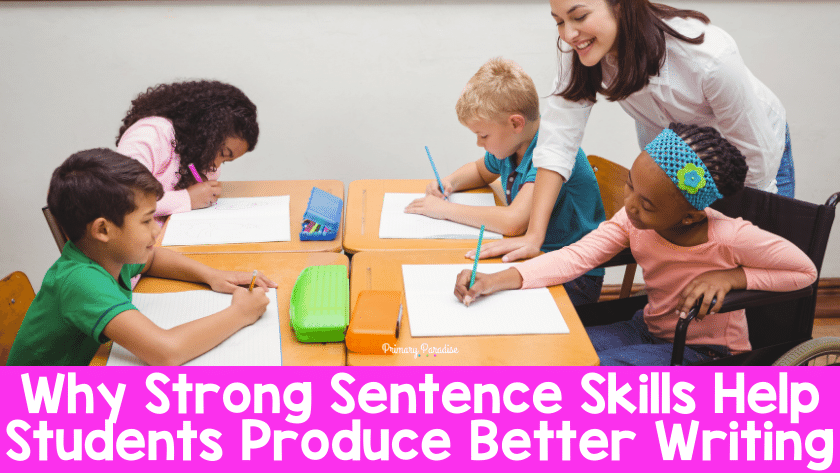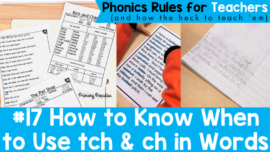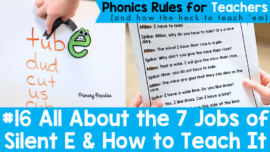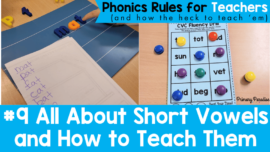Strong sentence understanding is the key to students producing strong writing pieces. Maybe this sounds like something that doesn’t even need to be said to you. However, I’ve found that teachers often don’t spend enough time developing firm sentence understanding in their students. This leads to frustrated teachers and students who lack confidence. So, let’s explore why strong sentence skills are so important to improved writing, and how to teach our students those all important skills.
3 Reasons Strong Sentence Skills are Important
Understanding how sentences work helps unstick our students
We’ve all had students who sit and sit without writing a thing when it’s time to write. “I just don’t know what to write!” Often times, it’s not that they don’t know what write, it’s that they don’t know how to actually write it. When students have strong sentence skills, they can get right to work. They won’t get caught on how to write. Instead, they can start putting their thoughts and ideas down on paper. Of course, they’ll still need support with their writing, but it will make getting started so much easier.
Understanding how to create sentences gives our students the means to express themselves
If you’ve ever spoken with a primary grade student about anything, you know kids are fabulous story tellers. Sure, the plot might wonder a bit, but they often tell detailed, interesting stories verbally. When students know how to confidently form sentences, we give our students the means to express themselves in writing. This gives them the freedom to create vivid, detailed written stories. They’ll feel more confident getting creative with word choice when they’re not solely focused on the mechanics of writing a “correct” sentence.
Writers who understand sentences create more interesting and creative writing pieces
The more confident students are in their ability to write a sentence, the less they have to focus on the sentence structure part. It gives students the freedom to play around with their sentence structure, word choice, and style. It’s just like riding a bike. If someone is totally focused on not falling over, they probably won’t be popping a wheelie anytime soon. But, once the balancing and pedal become second nature, they can begin to focus on fun tricks. And, just like you don’t want a child who just took off their training wheels to try to do a figure 8, we need to give our students the tools and time they need to develop their sentence writing skills.
How to teach students about sentences
Okay, so if you’re thinking “great, I want my students to understand sentences, but how do I do that?”, let’s talk about the how. First, though, I want to make sure there’s no confusion. I am not in anyway saying that students can’t write stories before they understand sentences. Of course they can! Students can create stories with just pictures, inventive spelling words, and teacher support. We just need to also work on giving them a firm foundation in sentence writing at the same time. So, here’s exactly how we can foster a strong understanding of sentence structure in our students.
start with the basics of sentence structure
First, start with the very basics of sentences. Hopefully students have learned this in Kindergarten, but it never hurts to spend time on it, even as a review, in first and second grade. When I say basics, I mean the very basics. Spend time on the difference between letters, words, and sentences, capitals and punctuation, spacing, and the parts of a sentence. Typically, I take a full week to work on these concepts, but you can take more or less time as needed. You can read in detail how I structure each lesson in this post.
get more complex
Once students have basic sentences down, it’s time to get more complex. Three and four word sentences are fine, but they’re not enough to create rich writing pieces. After students have had time to practice with simple sentences, and they’re writing them, correctly consistently, it’s time to introduce them to their new best friends: subject and predicate. Understanding subject and predicate can solve a host of sentence writing issues. Again, I typically take a week to focus on this topic. You can read exactly how and why I teach this here. However, the cliff notes version is this: Understanding subject and predicate will help students know when to start and end their sentences. It will also help avoid fragments and run-ons.
teach them how to write with detail
Once your students know when to start and end a sentence, we get to the fun part: making sentences interesting! Next, teach your students how to expand their sentences by adding details. My favorite, and in my opinion the simplest, way to do this is using the five sentences. This works so well because it’s concrete and something familiar. You can read how I do it in this post (and grab a free resource to help!).
teach them to show not tell
Another favorite method to help students understand how to create interesting sentences is to teach them how to Show, Not Tell. This method expands a bit on adding detail with the senses above, and it’s highly engaging and effective! You can find 5 ways to teach students to show, not tell in this post. (And also grab a free, digital resource to use.)
help them plan their writing
Lastly, we can help students plan out their writing. This is a step you want to do from the beginning because good modeling and guidance makes all of the difference. If you’re not sure the best way to help students plan out their writing, you can learn about a simple and effective 3 step method to plan writing here.
Taking the time to help students develop a firm understand of sentences is time well spent. It will save you, and your students, so much time and frustration.




